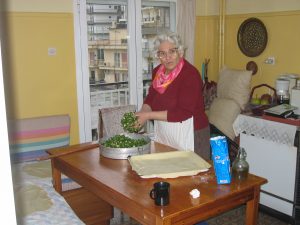Six years have passed in a blink. In 6 more perhaps, though certainly in 12, your world’s horizon will be much broader than it is today and I will occupy a very small part in it. This is good. But I have a lot I wish to share with you and much I wish for you to carry with you. These are my letters to you.
Your roots are both broad and deep. Parts of them reach down to a region of Greece known as Epirus, in the capital of which, Giannena, I grew up. Your grandmother also grew up there, in the old citadel, to poor but honest parents. My giagia, Olympia, was a limited cook, but knew how to make one thing well: pita. Pita is the generic name for all pastries, typically made with filo, but sometimes with batters or other doughs. Their fillings are usually savoury, but sweet ones exist too. Pita to Epirotes is like bread; a staple. I do not remember special meals ever not to include one or two pitas.
Olympia made very good filo. A few years after I left home for university, I asked her to teach me. She did, though I have not practiced much since then. I will teach you, if you like. You can find good filo in shops, but the knowledge is part of your heritage; part of your roots. You can learn more about yourself by learning about the cultures that have shaped you.
As you grow, you have eaten many pitas at our home. Prasopita, made with a filling of leeks and feta, hortopita, made with wild greens, alevropita from the Zagoria villages, spanakopita, of course, and various others that we’ve made at home. You have already rolled your own tiropitakia, brushing oil on the filo, folding them in neat triangles filled with cheese and wild garlic.
I am happy, and a bit surprised, you like prasopita as much as you do. We had it for dinner tonight. Crunch crunch crunch, you ate two pieces and some salad. No yoghurt, though that is traditional in my part of the world. The rich, oily flavour of pita takes well to yoghurt. I will share how I make prasopita with you.
There are many kinds of filo; we value thinness more than anything else. Avoid yufka-type filo and either go for a Greek brand at the supermarket or find filo for baklava, which tends to be very thin but strong. Don’t make a small pita. Make it as wide and thin as you can. I don’t imagine we make it thicker than a couple of centimeters. The filling is simple. Buy leeks that are mostly white and not much green. The green parts are tough and you throw a lot of them away. Three or four large leeks will make a large pita. Remove the root end and much of the dark green ends, keeping as much of the tender green parts as you can. Cut in half lengthways, without letting the halves separate in layers. Dirt and mud often hides within the layers, mostly on the green ends. Run them under cold water and carefully wash the dirt away, spreading the layers with your fingers. A little dirt won’t kill you but the grit is not pleasant. Slice the two halves in very thin slivers (a millimeter or three; don’t be precious, though). Place in a large bowl. Repeat with all the leeks. Crumble, don’t dice, with your fingers about 300-350gr of feta. Dodoni, a company in Giannena, exports worldwide. It’s what we’ve always used. Instead of adding much salt in the filling, I like to use the brine from the tin, but packets don’t always have it, so season accordingly. Add olive oil. Pita takes a lot of oil so it “cooks” as my mother used to say. She meant that it roasts instead of steaming in the moisture of the vegetables. You will get a feel for this, it’s perhaps a couple of espresso cups of oil for this size of pita.
Oil the roasting tin; the broadest you can find. I typically use the tray that came with the oven. Oil it generously. Layer a couple of sheets of filo, hanging over the edge. Add a couple more in the centre. Top with half the filling; spread evenly. Add another sheet, sort of rumpled into the filling. Add the remaining filling. Top with a couple of sheets of filo and bring the bottom overhanging edges over the middle. Add a couple more sheets and tuck the edges into the sides and under the pita if possible, gently. I like to score the pita into pieces while it is raw (though neither your or my giagia did that). Do that gently and with a sharp knife. Drizzle more olive oil. And an espresso cup of water. Cover loosely with aluminium foil and place on the bottom third of a preheated oven (190C) for about 50min. Remove the foil; cook until you’re happy with it. Let it sit for 15 or more minutes before serving it.
Now, everything I’ve described you will make your own and change according to your ingredients, temperament, tastes, and nature. This is good too. Aim less to recreate with exactitude what I made for you and more to carry on this manner of cooking and to understand it in your own context. That will do it the greatest justice.
I love you.
_papa

